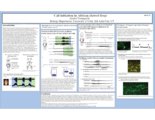|
|
Creator | Title | Description | Subject | Date |
| 176 |
 | Yamaguchi, Ayako | Call initiation in African clawed frogs | Society for Neuroscience Meeting 2016 | vocalizations; Xenopus laevis | 2016 |
| 177 |
 | Gondolo, Paolo | Can WIMP spin dependent couplings explain DAMA data, in light of null results from other experiments? | We examine whether the annual modulation found by the DAMA dark matter experiment can be explained by Weakly Interacting Massive Particles (WIMPs), in light of new null results from other experiments. CDMS II has already ruled out most WIMP-nucleus spin-independent couplings as an explanation for DA... | WIMP; Weakly interacting massive particles; DAMA; CDMS II; Parameter space | 2004-12 |
| 178 |
 | Jorgensen, Erik; Schuske, Kimberly R. | CAPS and syntaxin dock dense core vesicles to the plasma membrane in neurons | Docking to the plasma membrane prepares vesicles for rapid release. Here, we describe a mechanism for dense core vesicle docking in neurons. In Caenorhabditis elegons motor neurons, dense core vesicles dock at the plasma membrane but are excluded from active zones at synapses. | | 2008 |
| 179 |
 | Hultine, Kevin | Carbon and nitrogen allocation to male and female reproduction in Rocky Mountain Douglas-fir (Pseudotsuga menziesii var. glauca, Pinaceae) | We measured carbon (respiration, photosynthesis, and production) and nitrogen allocation to male and female cones of Rocky Mountain Douglas-fir (Pseudotsuga menziesii var. glauca) to quantify gender-specific: (1) resource allocation to reproduction, and (2) contribution to carbon costs of reproducti... | Gender; photosynthesis; resource allocation | 2000 |
| 180 |
 | Ehleringer, James R. | Carbon isotope discrimination and water relations of oak hybrid populations in southwestern Utah | The evergreen oak Quercus turbinella and the deciduous Q. gambelii form natural hybrids in southwestern Utah and northern Arizona. Hybrid individuals also are found in northern Utah in a region where only Q. gambelii currently exists, indicating that Q. turbinella has recently retreated southward. ... | Quercus turbinella; Oak hybrids; Leaf structure; Leaf nitrogen; Carbon isotope discrimination; Water potential; Oak ecology | 2000 |
| 181 |
 | Ehleringer, James R. | Carbon isotope discrimination in the C4 shrub Atriplex confertifolia along a salinity gradient | Carbon isotope discrimination (∆) was measured for leaves of Atriplex confertifolia along a salinity gradi~ ent in northern Utah. Over this gradient, the variation of ∆ values was high for a C4 species, and the ∆ values were positively correlated with salinity in both years of the study. Of th... | Carbon isotope ratio; Salt stress; Bundle sheath leakiness; Halophyte; Atriplex confertifolia; Salinity gradient | 1995 |
| 182 |
 | Ehleringer, James R. | Carbon isotope dynamics in Abies amabilis stands in the Cascades | Carbon isotope ratios (d13C) of canopy air and carbon isotope discrimination at the ecosystem level were studied in three montane Pacific silver fir (Abies amabilis (Dougl. ex Loud.) Dougl. ex J. Forbes) stands, an old-growth and two younger stands. Spatial and temporal variations of canopy CO2 con... | Carbon isotopes; Pacific silver fir; Carbon budget; Soil respiration; Cascade Mountains | 1998 |
| 183 |
 | Ehleringer, James R. | Carbon isotope ratios in belowground carbon cycle processes | Analyses of carbon isotope ratios (δ13C) in soil organic matter (SOM) and soil respired CO2 provide insights into dynamics of the carbon cycle. δ13C analyses do not provide direct measures of soil CO2 efflux rates but are useful as a constraint in carbon cycle models. In many cases, δ13C analyses... | Below ground processes; Ecosystems; Carbon cycle; Carbon isotope ratio; Ecosystem processes; Global change; Soil organic carbon; Soil organic matter | 2000 |
| 184 |
 | Ehleringer, James R. | Carbon isotope ratios of Atacama Desert plants reflect hyperaridity of region in northern Chile | Leaf carbon isotope ratios were measured on plants from the coastal portions of the Atacama Desert at Pan de Azucar and Paposo, Chile. Most species possessed C3 photosynthesis, although there were several CAM species, indications of some facultative CAM species, and only one C4 species. The carbon i... | Atacama Desert; Carbon isotope ratio; Intercellular carbon dioxide concentration; Hyperaridity | 1998 |
| 185 |
 | Orendt, Anita; Pugmire, Ronald J. | Carbon-13 chemical shift tensors in polycyclic aromiatic compounds. 9. Biphenylene | The principal values of the 13C chemical-shift tensors of natural abundance biphenylene were measured at room temperature with the FIREMAT experiment. Of 18 crystallographically distinct positions (three sets of six congruent carbons each), the three primary bands have been resolved into seven singl... | Carbon-13; Chemical-shift tensors; Biphenylene; Polycyclic aromiatic compounds; FIREMAT | 2000 |
| 186 |
 | Carter, Tony M. | Cascade: hardware for high/variable precision arithmetic | The Cascade hardware architecture for high/variable precision arithmetic is described. It uses a radix-16 redundant signed-digit number representation and directly supports single or multiple precision addition, subtraction, multiplication, division, extraction of the square root and computation... | | 1989 |
| 187 |
 | Poulter, Charles Dale | Catalytic mechanism of Escherichia coli isopentenyl diphosphate isomerase involves Cys-67, Glu-116, and Tyr-104 as suggested by crystal structures of complexes with transition state analogues and irreversible inhibitors | Isopentenyl diphosphate (IPP):dimethylallyl diphosphate (DMAPP) isomerase is a key enzyme in the biosynthesis of isoprenoids. The reaction involves protonation and deprotonation of the isoprenoid unit and proceeds through a carbocationic transition state. Analysis of the crystal structures (2 A) of ... | Catalytic Domain; Crystallography; Organophosphorus Compounds | 2003-04-04 |
| 188 |
 | Sekercioglu, Cagan | Causes and consequences of bird extinctions | Increased human domination of the planet has caused the declines and extinctions of countless species. Each species has not only intrinsic value, but ecological functions of organisms are also essential for the integrity of ecosystems that allow people to benefit from essential free ecosystem servic... | | 2003-01-01 |
| 189 |
 | Torti, Sylvia D.; Coley, Phyllis D.; Kursar, Thomas A. | Causes and consequences of monodominance in tropical lowland forests | Tropical canopy dominance in lowland, well-drained forests by one plant species is a long-standing conundrum in tropical biology. Research now shows that dominance is not the result of one trait or mechanism. We suggest that the striking dominance of Gilbertiodendron dewevrei in the Ituri Forest of ... | Monodominance; Gilbertiodendron dewevrei; Ituri Forest; Understory | 2001 |
| 190 |
 | Sperry, John S. | Cavitation fatigue - the weakening of cavitation resistance of xylem and its reversibility | Xylem function is essential for the growth and survival of higher land plants. Xylem must not only be efficient under favorable conditions to facilitate high rates of stomatal conductance and carbon uptake, but it should also remain functional under drought conditions, when water potential (Ψ) dro... | Cavitation fatigue; Drought; Pit membrane | 2003 |
| 191 |
 | Dawson, Kyle | CCD testing and characterization for dark energy survey | A description of the plans and infrastructure developed for CCD testing and characterization for the DES focal plane detectors is presented. Examples of the results obtained are shown and discussed in the context of the device requirements for the survey instrument. | DES | 2006 |
| 192 |
 | Davidson, Diane W. | Cecropia and its biotic defenses | In all the world, the genus Cecropia is unrivaled for the number of myrmecophytes, or true "antplants" counted among its species (McKey & Davidson, 1993). Based on the proportion of Cecropia species producing Mullerian bodies in at least some parts of their distribution, myrmecophytes comprise the ... | Myrmecophytes; Mullerian bodies; Pearl bodies | 2005 |
| 193 |
 | Carter, Tony M.; Smith, Kent F. | Cell matrix methodologies for integrated circuit design | A class of integrated circuit design and implementation methodologies is described. These techniques are unique in that they simultaneously model both function and interconnect using cells. These cells are designed such that cell adjacency normally implies interconnection. The absence of an interco... | Integrated circuit design; Cell matrix | 1989 |
| 194 |
 | Bastiani, Michael | Cell-cell interactions during the migration of an identified commissural growth cone in the embryonic grasshopper | One of the fascicles of the posterior commissure of the embryonic grasshopper is pioneered by an individually identifiable neuron named Q1. Q1 initially grows along a longitudinal pathway established by another pioneer neuron, MPl, and then crosses to the midline, where it meets and fasciculates wi... | Commissure; Pathfinding; Filopodia | 1993 |
| 195 |
 | Gesteland, Raymond F. | Cell-free synthesis of herpes simplex virus proteins | Polyribosomes isolated from herpes simplex virus type I (HSV-1)-infected cells have been used to program a eucaryotic cell-free translation system. At least 10 HSV-specific polypeptides, with apparent molecular weights of 25,000 to 160,000, are synthesized by wild-type HSV-infected polyribosomes. Po... | Viral Proteins; Herpes Simplex; Peptide Biosynthesis; Thymidine Kinase | 1977 |
| 196 |
 | Bastiani, Michael | Central projections of the stretch receptor neurons of crayfish: segmental gradients of synaptic probability and strength | The 20 stretch receptor neurons (SRs) of the crayfish abdomen send axons into the CNS that then project both to the brain and to the last abdominal ganglion, G6 (Bastiani and Mulloney, 1988). In G6, we recorded intracellularly from different kinds of neurons postsynaptic to SR axons. | Axons; Synapses; SR | 1988 |
| 197 |
 | Bastiani, Michael | Central projections of the stretch receptor neurons of crayfish: structure, variation, and postembryonic growth | Each stretch receptor neuron (SR) of the crayfish abdomen projects from its peripherally located soma an axon that enters the CNS through the second nerve (N2) of its segmental ganglion. CoZ+ backfills of N2 revealed that this axon bifurcates, sending one branch to the brain and the other to the te... | Abdomen; Axon; Ganglion | 1988 |
| 198 |
 | Symko, Orest George | Chaos in long Josephson junctions without external rf driving force | Simulations of long Josephson junctions in an external magnetic field show a variety of chaotic behaviors. They consist of period-doubling bifurcation, intermittency between and within Fiske steps, and quasiperiodic motion at Fiske steps. A physical explanation for the chaotic behavior is presented.... | Fiske steps; Chaos; Chaotic behaviors | 1990-09 |
| 199 |
 | Symko, Orest George | Characteristics of YBaCuO magnetic shields | Magnetic shielding properties of YBaCuO tubes have been studied at temperatures of 77 K and 4 K. Shielding effectiveness was determined by measuring the magnetic field inside the tube in the presence of external magnetic fields. A high degree of shielding was achieved up to a critical external fie... | YBaCuO magnetic shields; SQUID | 1991-03 |
| 200 |
 | Gesteland, Raymond F. | Characterization of lysozyme messenger and lysozyme synthesized in vitro | In vitro systems for protein systhesis have been in wide use for about 10 years. In most of the early work protein synthesis was measured by following the incorporation of radioactive amino acids into acid precipitable material. This test cannot distinguish between the synthesis of complete, activ... | Lysozyme Messenger; Lysozyme Synthesized; Protein Synthesis | 1969 |

























